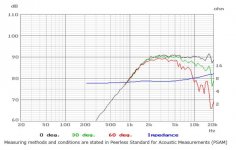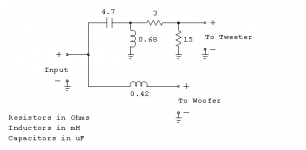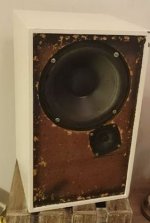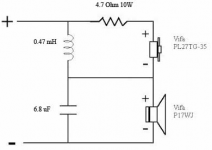The use of a tweeter waveguide to control directivity has some advantages for HT in a modest volume room. Fewer short delay wall/floor reflections that garble soundstage quality, and improved clarity across a family HT couch. A waveguide allows a lower crossover frequency to the woofer than is possible with a small dome. This solves the common problems of an 8" woofer with an 1" tweeter. There are waveguides for dome tweeters, and for compression driver tweeters designed to work with modest size woofers like yours. Several top audio companies sell small wavguide speakers with good success and good reviews.
Worth some study before you spend $$ on new crossover parts. Maybe, long term evolution for your "favorite box"?
Check local speakers vendors for component options. The JBL LSR308 waveguide speaker is a good size example.
SEOS-8? for domes DIY Sound Group
Worth some study before you spend $$ on new crossover parts. Maybe, long term evolution for your "favorite box"?
Check local speakers vendors for component options. The JBL LSR308 waveguide speaker is a good size example.
SEOS-8? for domes DIY Sound Group
Last edited:
Yep, let's just get him to the point where he knows how to measure his speakers, design a crossover first. 🙂
Best,
Erik
Best,
Erik
I bow to thee master! I shall pass this secret on to my future disciple.Yes, curtains are great. There's a secret way to select curtains I will share only with you. This secret is passed down from master to one and only one disciple.
When you go shopping or looking for curtains, put your ear up to them. You will hear some curtains sound more silent than others. That's what you want. 🙂
You can do this experiment wiht a thick towel. Just bunch it up and put it next to, but not blocking your ear. That's acoustics! 🙂
Best,
Erik
I will probably look for curtains or a good mat to cover the floor. Something too absorb the waves =)
Thanks for the info, i will keep this in mind for my future work to these speakers but i would gladly spend a bit to get a good crossover on the unmodified speakers then if i wan't to redesign or improve them this might be a good way to go even if that results in buying new crossover parts =)The use of a tweeter waveguide to control directivity has some advantages for HT in a modest volume room. Fewer short delay wall/floor reflections that garble soundstage quality, and improved clarity across a family HT couch. A waveguide allows a lower crossover frequency to the woofer than is possible with a small dome. This solves the common problems of an 8" woofer with an 1" tweeter. There are waveguides for dome tweeters, and for compression driver tweeters designed to work with modest size woofers like yours. Several top audio companies sell small wavguide speakers with good success and good reviews.
Worth some study before you spend $$ on new crossover parts. Maybe, long term evolution for your "favorite box"?
Check local speakers vendors for component options. The JBL LSR308 waveguide speaker is a good size example.
SEOS-8? for domes DIY Sound Group
I think we should start there!Yep, let's just get him to the point where he knows how to measure his speakers, design a crossover first. 🙂
Best,
Erik
I have fixes task 1 for the day, i bought myself a multimeter!
I "accidently" ended up with another meter that was a bit more money but had true RMS and some other features that i could have good use for in other projects.
True RMS Digital Multimeters-UNI-T
Very nice ! Spend as much as you'd like, so long as other DIY'ers don't accuse me of making you spend money that you don't need to, which I will do when we get to the capacitors. 🙂
Best,
Erik
Best,
Erik
I think its well spent =)Very nice ! Spend as much as you'd like, so long as other DIY'ers don't accuse me of making you spend money that you don't need to, which I will do when we get to the capacitors. 🙂
Best,
Erik
I guess ill be swetting when we get to the caps part ^^
Im trying to measure my output voltage now and im still confused, now i get readings but they are way to low! If i max my amp out at "+14db" im still 1V from the goal??
50Hz Sine Wave
I get these values:
Speaker disconnected:
-30dB : 0.011V AC
0dB : 0.365V AC
+14dB : 1.836V AC
Speaker connected:
0dB : 0.838V AC
Usual listening volume is about -30dB to -20dB
The meter is set like this, + probe in + and - probe in - ...:

Last edited:
Just to get some kind of understanding, how loud is a speaker at 2,83V? Will i be able to be close to it without ear protection? Im just trying to understand whats wrong here, i know my amp can output louder volumes than im comfortable playing so thats why im comfused 😛
Hahaha. 🙂 Thanks for the picture, that explains a lot. 🙂
There is speaker level and signal level. 🙂
Signal level in consumer is often maximum of 2 volts. Usually a lot less.
Speaker level can be 50 volts or more. 🙂
They are not the same voltage. That is, amplifiers usually have about 28 db of voltage gain between input and output.
So, when I say your output should be 2.83 V I mean at the speaker outs, not signal outs. 🙂
There is speaker level and signal level. 🙂
Signal level in consumer is often maximum of 2 volts. Usually a lot less.
Speaker level can be 50 volts or more. 🙂
They are not the same voltage. That is, amplifiers usually have about 28 db of voltage gain between input and output.
So, when I say your output should be 2.83 V I mean at the speaker outs, not signal outs. 🙂
You can use the db to voltage ratio calculator here.
Plugging in 28 db we get a ratio of around 25. That is, for a 1 VAC input, your average power amplifier would produce 25x that, or 25 VAC.
28 db gain in a stand-alone power amplifier is about the convention. Not necessarily true for receivers, since they integrate the volume, preamp, etc this varies according to the volume control.
Anyway, for a 2.83V output a standalone amplifier would need only about 0.112mV input.
Best,
Erik
Plugging in 28 db we get a ratio of around 25. That is, for a 1 VAC input, your average power amplifier would produce 25x that, or 25 VAC.
28 db gain in a stand-alone power amplifier is about the convention. Not necessarily true for receivers, since they integrate the volume, preamp, etc this varies according to the volume control.
Anyway, for a 2.83V output a standalone amplifier would need only about 0.112mV input.
Best,
Erik
Sometimes I read a thread and think you guys are making it more difficult than it is!
This is a foam surround polycone which is doubtless quite well-behaved on it's own. Just like the old Vifa P17WJ.
Vifa 2-Way Loudspeaker System
And a classic old peerless CT62H cone tweeter. Marshall Leach's circuit will probably do about the right things, though you can do more. 6" polycone is an easy speaker. Possibly 2.5kHz crossover. I'd spray the baffle black too.
This is a foam surround polycone which is doubtless quite well-behaved on it's own. Just like the old Vifa P17WJ.
Vifa 2-Way Loudspeaker System
And a classic old peerless CT62H cone tweeter. Marshall Leach's circuit will probably do about the right things, though you can do more. 6" polycone is an easy speaker. Possibly 2.5kHz crossover. I'd spray the baffle black too.
Attachments
Last edited:
Sometimes I read a thread and think you guys are making it more difficult than it is!
This is a foam surround polycone which is doubtless quite well-behaved on it's own. Just like the old Vifa P17WJ.
Vifa 2-Way Loudspeaker System
And a classic old peerless CT62H cone tweeter. Marshall Leach's circuit will probably do about the right things, though you can do more. 6" polycone is an easy speaker. Possibly 2.5kHz crossover. I'd spray the baffle black too.
Hi steve,
My friend here seems to want to keep his speaker and use it to learn about speaker and crossover design.
If im wrong and he just wants to build a kit then of course this is too complicated. however no one is hatched as knowledgeable as you are. I think for him this is a fine path, cheap too for now.
Best
Erik
This is a foam surround polycone which is doubtless quite well-behaved on it's own. Just like the old Vifa P17WJ.
Vifa 2-Way Loudspeaker System
And a classic old peerless CT62H cone tweeter. Marshall Leach's circuit will probably do about the right things, though you can do more. 6" polycone is an easy speaker. Possibly 2.5kHz crossover. I'd spray the baffle black too.
Steve,
I actually learned what little I know and everything I've forgotten about crossover design auditing a class at Georgia Tech, from Dr. Leach, but that's not his circuit.
As far as I know, it did come from his lab and a graduate student of his but the correct attribution of that design should go to Kirk Wrzesien I believe. I'm in the process of making an homage to the late Dr. on my blog using Vifa and Peerless parts. I'll share when it's done.
Best,
Erik
Well, TBH, Erik, I'm winging it here. But 6" polycone plus tweeter is a well travelled road.
You can end up with the simple circuits like below:
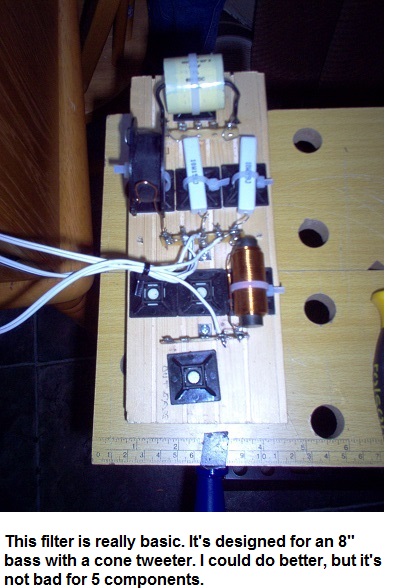
And then fiddle with tweeter level to get it balanced. The perfect can be the enemy of the good, and I always sim it with similar drivers to see what it does electrically.
Downloads
Now, some people do simple series filters like below, but that is just TOO Mickey Mouse and rough and ready IMO.
You can end up with the simple circuits like below:

And then fiddle with tweeter level to get it balanced. The perfect can be the enemy of the good, and I always sim it with similar drivers to see what it does electrically.
Downloads
Now, some people do simple series filters like below, but that is just TOO Mickey Mouse and rough and ready IMO.
Attachments
Well, TBH, Erik, I'm winging it here. But 6" polycone plus tweeter is a well travelled road.
You can end up with the simple circuits like below:

And then fiddle with tweeter level to get it balanced. The perfect can be the enemy of the good, and I always sim it with similar drivers to see what it does electrically.
Downloads
Now, some people do simple series filters like below, but that is just TOO Mickey Mouse and rough and ready IMO.
You make beautiful crossovers Steve. 🙂 But this gentleman is starting from 4 drivers and two caps of different values. Let's wait for him to figure out his measurements first.
He's almost to the point where he can enter your sample crossover and see what it does.
Best,
Erik
I have finally managed to set the voltage in the correct ballpark! I was initially using Room EQ Wizard and that had output signal set to "-20dB".. I totally missed that yesterday 🙄 Now i switched to Tone and did the 50Hz voltage setting at "-0dB". I managed to set the level to 2.90V. I think that will have to do it for now.
I'm using Tombstone for the curves. Something i noticed is when i use this high volume i get "Input was overloaded during the test" every time(as you also see on the curves upper left corner). Im not sure what that means but i think it feels strange that the curves are so smooth on "0dB", might be something?
I added a carpet and a peace of cloth on the walls on either side of the speaker.
Tweeter no cap 2.90V 500Hz+ - Right Speaker

Tweeter + cap 2.90V - Right Speaker

Woofer 2.90V - Right Speaker

Full + cap 2.90V - Right Speaker

I'm using Tombstone for the curves. Something i noticed is when i use this high volume i get "Input was overloaded during the test" every time(as you also see on the curves upper left corner). Im not sure what that means but i think it feels strange that the curves are so smooth on "0dB", might be something?
I added a carpet and a peace of cloth on the walls on either side of the speaker.
Tweeter no cap 2.90V 500Hz+ - Right Speaker

Tweeter + cap 2.90V - Right Speaker

Woofer 2.90V - Right Speaker

Full + cap 2.90V - Right Speaker

Last edited:
2,90V was really quite loud btw 😛
Full no cap 2.90V - Right Speaker

Did another sweep of the tweeter to make sure the full sweep without cap did not damage it:
Tweeter no cap 2.90V 500Hz+ - Right Speaker

This is the error message i get when using this high volume

Full no cap 2.90V - Right Speaker

Did another sweep of the tweeter to make sure the full sweep without cap did not damage it:
Tweeter no cap 2.90V 500Hz+ - Right Speaker

This is the error message i get when using this high volume

Move your microphone further away or turn the level down. 🙂 It would be nice if we could measure at 1 watt, but it's the least of our worries.
Then i could just keep the mic at 3feet and lower the volume? Ive started another measurement series now with exactly the same setup but i keep the volume between trigger and "overload level"(Whatever that means). Its alot lower though.
It would be nice to get something useful tonight =) its 21:42 here so its getting late for loud measurements 😛
It would be nice to get something useful tonight =) its 21:42 here so its getting late for loud measurements 😛
Yep. 🙂
Just make sure whatever volume you use is repeatable. So, if you can measure it on your fancy shiny multimeter that's best.
HEre's the benefit of the other way. In XSim when I select 20 watts on the amplifier, I can see the actual output levels in the FR. However the relative levels don't change. So if you enter data gathered at 1 Volt your absolute db levels will be too low, but the relative will be accurate.
Best,
Erik
Just make sure whatever volume you use is repeatable. So, if you can measure it on your fancy shiny multimeter that's best.
HEre's the benefit of the other way. In XSim when I select 20 watts on the amplifier, I can see the actual output levels in the FR. However the relative levels don't change. So if you enter data gathered at 1 Volt your absolute db levels will be too low, but the relative will be accurate.
Best,
Erik
Okey, so this is the curves with a lower volume, 0.815V to be exact. (Note to self: full volume on MBP, -21dB on amp)
Right-tweeter_no_cap-3ft-100db_scale-0,815V

Right-woofer-3ft-100db_scale-0,815V

Right-full_no_cap-3ft-100db_scale-0,815V

Right-full_cap-3ft-100db_scale-0,815V

Hope this is something useful 😀
Right-tweeter_no_cap-3ft-100db_scale-0,815V

Right-woofer-3ft-100db_scale-0,815V

Right-full_no_cap-3ft-100db_scale-0,815V

Right-full_cap-3ft-100db_scale-0,815V

Hope this is something useful 😀
It is repeatable =) 0.815VYep. 🙂
Just make sure whatever volume you use is repeatable. So, if you can measure it on your fancy shiny multimeter that's best.
HEre's the benefit of the other way. In XSim when I select 20 watts on the amplifier, I can see the actual output levels in the FR. However the relative levels don't change. So if you enter data gathered at 1 Volt your absolute db levels will be too low, but the relative will be accurate.
Best,
Erik
I haven't really understood the dB values on the curves, i see people with positive dB values of like 80-90dB but my maximum is at 0dB... I guess it has to do with absolute/relative values?
Does the curves look okey? =) Whats the next step? =)
- Status
- Not open for further replies.
- Home
- Loudspeakers
- Multi-Way
- 2 Way speakers - Suggestions on improvements?

